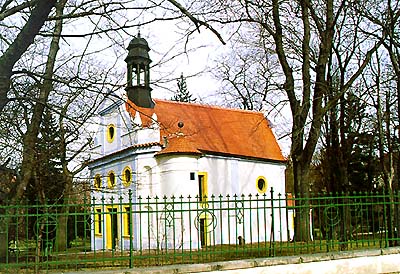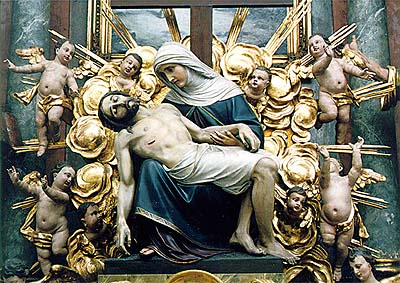St. Martin Chapel in
Location
Town
Park in Česky Krumlov
Description of the building
A one-nave oblong building with a three-sided presbytery and an
axial eastern sacristy. Three-axial western facade with rounded
corners is topped by a shield gable with volutes and niches cut
inside the round corners. Facades are divided by pilasters and the
sacristy by pilaster strips. The eastern end of the chapel is
decorated with a replica of the western facade. The ceiling is flat
and has two stucco mirrors within the presbyter and nave. Nine
shabby granite gravestones from 18th century lay on the path that
leads to the chapel.
Historical development of the
construction The chapel was built as a
wooden cemetery chapel in 1585 together as a part of new graveyard
which was to replace the old one at St. Vitus Church (see History
of Graveyards in Český Krumlov). A new chapel was to be built
in 1618 but the construction was interrupted by the estate
insurrection and the construction material was rather used for the
Castle fortification. The construction was then launched again
after 1717 together with a chapel on Křížova hora (Cross Hill). A
shelter for the ill stood right beside the chapel which was used by
the Jesuits as their sanctuary. The main altar from 1763 is a
masterpiece of Josef Muck, a sculptor from Český Krumlov, and
painters Josef Putz and Christoph Anneis. St. Martin's altar is
supposedly a masterpiece of Bedřich Kamarýt (1831-1911), a painter
and cleric from Velešín. A Rococo pulpit was created by a painter
and carver Anton Leyer. Side altars were consecrated to St. Johann
Nepomucensis and to St. Anna. The graveyard closed down in 1892 and
became a Town park in 1909.
The chapel was built as a
wooden cemetery chapel in 1585 together as a part of new graveyard
which was to replace the old one at St. Vitus Church (see History
of Graveyards in Český Krumlov). A new chapel was to be built
in 1618 but the construction was interrupted by the estate
insurrection and the construction material was rather used for the
Castle fortification. The construction was then launched again
after 1717 together with a chapel on Křížova hora (Cross Hill). A
shelter for the ill stood right beside the chapel which was used by
the Jesuits as their sanctuary. The main altar from 1763 is a
masterpiece of Josef Muck, a sculptor from Český Krumlov, and
painters Josef Putz and Christoph Anneis. St. Martin's altar is
supposedly a masterpiece of Bedřich Kamarýt (1831-1911), a painter
and cleric from Velešín. A Rococo pulpit was created by a painter
and carver Anton Leyer. Side altars were consecrated to St. Johann
Nepomucensis and to St. Anna. The graveyard closed down in 1892 and
became a Town park in 1909.
Current Utilization
Since 1969, the chapel has been used as a seat of the Czech
Hussitic Church Chorus. Occasionally, spiritual music concerts take
place there.
(jh, kol.)




